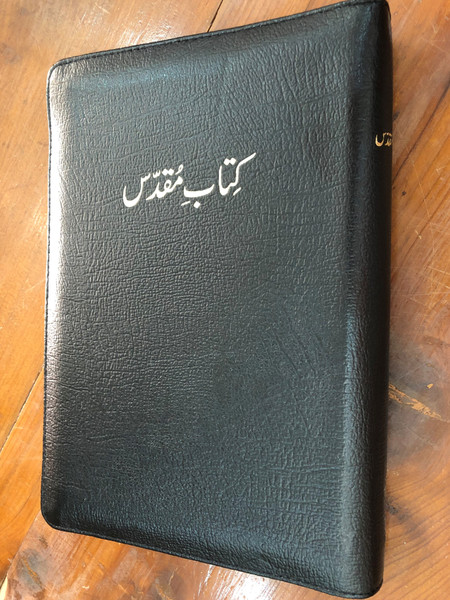Description
Urdu (Devanagari Script) Holy Bible: Stained Glass Theme with Charcoal-Grey Background / Hardcover Edition
Author: The Bible Society of India
Binding: Hardcover
Edition: 2014
Publisher: The Bible Society of India
Language: Urdu (with Hindi–Urdu transliteration)
ISBN: 8122129331
ISBN-13: 978-8122129335 / 9788122129335
Overview / جائزہ
The Urdu (Devanagari Script) Holy Bible features a stunning stained glass theme against a charcoal-grey background, making it a beautiful addition to any collection. This edition is specially designed to accommodate both Urdu readers and those familiar with Hindi through its transliteration. With its elegant presentation and faithful translation, this Bible serves as a valuable resource for personal study and communal worship.
اردو (دیواناگری اسکرپٹ) بائبل ایک شاندار داغدار شیشے کی تھیم کے ساتھ ہے جو کہ سیاہ گرے پس منظر پر ہے، جو کہ کسی بھی مجموعے میں ایک خوبصورت اضافہ ہے۔ یہ ایڈیشن خاص طور پر اردو قارئین اور ہندی کے ساتھ واقف افراد کے لیے بنایا گیا ہے۔ اس کی نفیس پیشکش اور وفادار ترجمہ کے ساتھ، یہ بائبل ذاتی مطالعے اور اجتماعی عبادت کے لیے ایک قیمتی وسیلہ ہے۔
Product Features / مصنوعات کی خصوصیات
-
Stunning Design: Features a unique stained glass theme, combining artistry and spirituality.
حیرت انگیز ڈیزائن: منفرد داغدار شیشے کی تھیم، فن اور روحانیت کو ملا کر پیش کرتا ہے۔ -
Hardcover Binding: Durable and elegant, ensuring longevity and ease of use.
ہارڈکور بندش: پائیدار اور خوبصورت، طویل عمر اور استعمال میں آسانی کو یقینی بناتا ہے۔ -
Hindi–Urdu Transliteration: Aids readers in understanding the Urdu text through Hindi phonetics, enhancing accessibility.
ہندی-اردو نقل نویسی: اردو متن کو ہندی صوتیات کے ذریعے سمجھنے میں مدد کرتا ہے، جس سے رسائی میں بہتری آتی ہے۔
Publishers / ناشر
The Bible Society of India
Hashtags: #UrduHolyBible #StainedGlassBible #HindiUrduTransliteration #BibleSocietyOfIndia #ChristianLiterature
#اردوبائبل #داغدارشیشہبائبل #ہندیاردونقلنویسی
Hindi–Urdu (Devanagari: हिन्दी-उर्दू, Nastaliq: ہندی-اردو) (also known as Hindustani) is the lingua franca of modern-day Northern India and Pakistan (together classically known as Hindostan). Modern Standard Hindi is officially registered in Indian Republic as a standard written using Devanagari script, and Urdu is officially registered in Pakistan as a standard written using extended Perso-Arabic script.
Hindi–Urdu transliteration (or Hindustani transliteration) is essential for Hindostani speakers to understand each other's text, and especially important since the underlying language of both the Hindi & Urdu registers are almost the same. Transliteration is theoretically possible because of the common Hindustani phonology underlying Hindi-Urdu. In present day, the Hindustani language is seen as a unifying language, as initially proposed by Mahatma Gandhi to resolve the Hindi–Urdu controversy. ("Hindustani" is not to be confused with followers of Hinduism, as 'Hindu' in Persian means 'Indo')
Technically, a direct one-to-one script mapping or rule-based lossless transliteration of Hindi-Urdu is not possible, majorly since Hindi is written in an abugida script and Urdu is written in an abjad script, and also other constraints like multiple similar characters from Perso-Arabic which map onto a single character in Devanagari. However, there have been dictionary-based mapping attempts which have yielded very high accuracy, providing near-to-perfect transliterations. For literary domains, a mere transliteration between Hindi-Urdu will not suffice as formal Hindi is more inclined towards Sanskrit vocabulary whereas formal Urdu is more inclined towards Persian and Arabic vocabulary; hence a system combining transliteration and translation would be necessary for such cases.
In addition to Hindi-Urdu, there have been attempts to design Indo-Pakistani transliteration systems for digraphic languages like Sindhi (written in extended Perso-Arabic in Sindh of Pakistan and in Devanagari by Sindhis in partitioned India), Punjabi (written in Gurmukhi in East Punjab and Shahmukhi in West Punjab), Saraiki (written in extended-Shahmukhi script in Saraikistan and unofficially in Sindhi-Devanagari script in India) and Kashmiri (written in extended Perso-Arabic by Kashmiri Muslims and extended-Devanagari by Kashmiri Hindus).

























































![Urdu Holy Bible AUDIO / Audio Urdu Bible 3 CD's [CD-ROM] Urdu Holy Bible AUDIO / Audio Urdu Bible 3 CD's [CD-ROM]](https://cdn11.bigcommerce.com/s-62bdpkt7pb/images/stencil/600x600/products/1628/2479/1__98775.1462823167.JPG?c=2)












